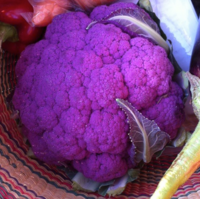
Photo from wikipedia
In the present study, we evaluated a pretreatment with four LED light sources (red, blue, red + blue, and white) in two genotypes (green and purple) of basil on the growth parameters,… Click to show full abstract
In the present study, we evaluated a pretreatment with four LED light sources (red, blue, red + blue, and white) in two genotypes (green and purple) of basil on the growth parameters, stress oxidative markers, non-enzymatic antioxidants, osmoprotectant compounds, ion content, and polyphenolic profile under both control and salinity stress conditions. The results indicated that 150 mM of NaCl decreased biomass, RWC, and K+/Na+ ratio but increased the content of proline and antioxidant capacity in the leaves of both genotypes of basil grown under GH (greenhouse) conditions. The results suggested that RB LED-exposed plants in the green genotype and R LED-exposed plants in the purple genotype improved accumulation of shoot biomass, K+/Na+ ratio, proline and soluble sugars, glutathione and ascorbate, polyphenolic profile, and thioredoxin reductase activity in the leaves of basil under both control and salinity stress conditions. NaCl stress (150 mM) increased oxidative markers, which are responsible for disturbance of routine functions of various plant cellular modules. LED light pretreatments diminished these markers under both control and salinity stress conditions. It could be concluded that intensification of non-enzymatic antioxidant systems during light-mediated priming can diminish the deleterious effects of ROS induced by NaCl stress (150 mM) through preventing the lipid peroxidation, scavenging cytotoxic H2O2, and enhancement of antioxidant potentials. Therefore, usage of LED lighting systems as a pretreatment or to supplement natural photoperiods under both control and salinity stress conditions may be advantageous for increasing biomass and phytochemical accumulation in basil.
Journal Title: Protoplasma
Year Published: 2022
Link to full text (if available)
Share on Social Media: Sign Up to like & get
recommendations!